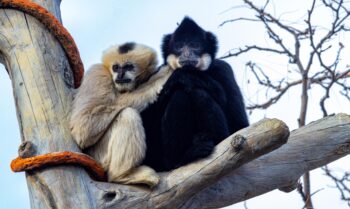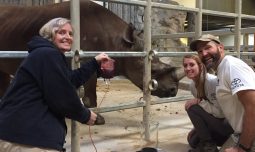May 6, 2019
Banking on Success
How Denver Zoo Veterinarians Collect Plasma to Ensure the Health of the Animals Under Our Care
By Stephanie Hinkle, Certified Veterinary Technician
When Dobby the reticulated giraffe was born in 2017, he faced life-threatening health issues. He wasn’t nursing enough, so he wasn’t getting vital antibodies, which put him at a high risk for infection and possibly death. But a plasma transfusion, with plasma from a Cheyenne Mountain Zoo giraffe, saved Dobby’s life. That same year, another plasma transfusion, with plasma from a Columbus Zoo okapi, saved our baby okapi Forest. Dobby’s and Forest’s stories are just a few of the successes that can be attributed to plasma and blood banking. And in the last few years, our veterinary medicine team has spent more time banking plasma and blood from the animals in our care, so that we can help the animals at our zoo and other institutions around the country.
Why Plasma?
Dobby and Forest benefited from the antibodies found in plasma, but plasma itself has many other uses. Plasma is the liquid portion of blood that carries cells and proteins throughout the body. In our Asian elephants, plasma transfusions can be crucial for treating a deadly virus called elephant endotheliotropic herpesvirus (EEHV), so it’s necessary that we have plasma on-hand to treat our elephants or share with other zoos if needed.
Trial and Error
One of the first animals we tried plasma banking with was Rudy, our 25-year-old black rhino. Rudy has iron storage disease, and one treatment for his condition is to collect nearly three liters of blood over the course of three weeks. In addition to helping lower his iron levels, it also gives us the opportunity to collect plasma during his treatments. Even though Rudy is already trained to participate in his own medical care, the vet tech team and his keepers had to try a few different techniques to collect enough blood in each session.
At first, gravity was not our friend. We collect blood at Rudy’s “wrists,” which are very close to the ground. That meant there was no way to get the bag low enough to collect more than a few milliliters of blood at a time. We switched to a different method, which helped us collect 250-500 mL, but that still required several sessions to get the desired amount of blood. We continued to use the technique for several months until I went to a conference at Columbus Zoo, where I was able to learn from other vet techs who had a technique that allowed them to collect up to a liter of blood in one session. We tried it with Rudy and collected a full liter in his first session!
Like Rudy, Groucho, our 50-year-old male Asian elephant, is also trained to work with keepers and participate in his medical care. Using the same technique we applied to Rudy’s collection, we went from collecting 500 mL of blood per session, to getting a whole liter of blood, which means more plasma to bank for our elephant herd. The vet tech team also works closely with the keepers at Toyota Elephant Passage to monitor for signs of EEHV in all our elephants.
Your Support
With a commitment to being a leader in animal care, Denver Zoo decided it was time to purchase our own plasma transfusion equipment. Not only is on-hand plasma vital to the health and longevity of animals here at Denver Zoo, but it will enable us to provide emergency transfusions to animals around the country.
Collectively, our donors have contributed more than $32,000 to purchase the plasma transfusion equipment. Your generosity will give us the power to perform instantaneous and life-saving transfusions for the animals that call Denver Zoo home.
Thank you for your commitment to Denver Zoo. From Dobby, Forest, Rudy, Groucho and many more, we are grateful for you.
Subscribe
Be among the first to hear the latest animal updates, important stories and details about all the fun happening around Denver Zoo.
Tags
-
 April 15, 2024
April 15, 2024Good Luck, Chuck!
Good Luck, Chuck! Beloved Bachelor Relocating as Part of Asian Elephant Species Survival Plan In a heartfelt and collaborative…
-
 April 15, 2024
April 15, 2024African Impact
African Impact Two New African Field Conservation ProgramsAim to Protect Gorillas + Grey Crowned Cranes We're honored to provide…
-
 March 1, 2024
March 1, 2024Last Place(s) on Earth
Last Place(s) on Earth New Asian Field Conservation Programs Protect Asian Elephants, Sumatran Orangutans + more Indonesia's Leuser Ecosystem…


